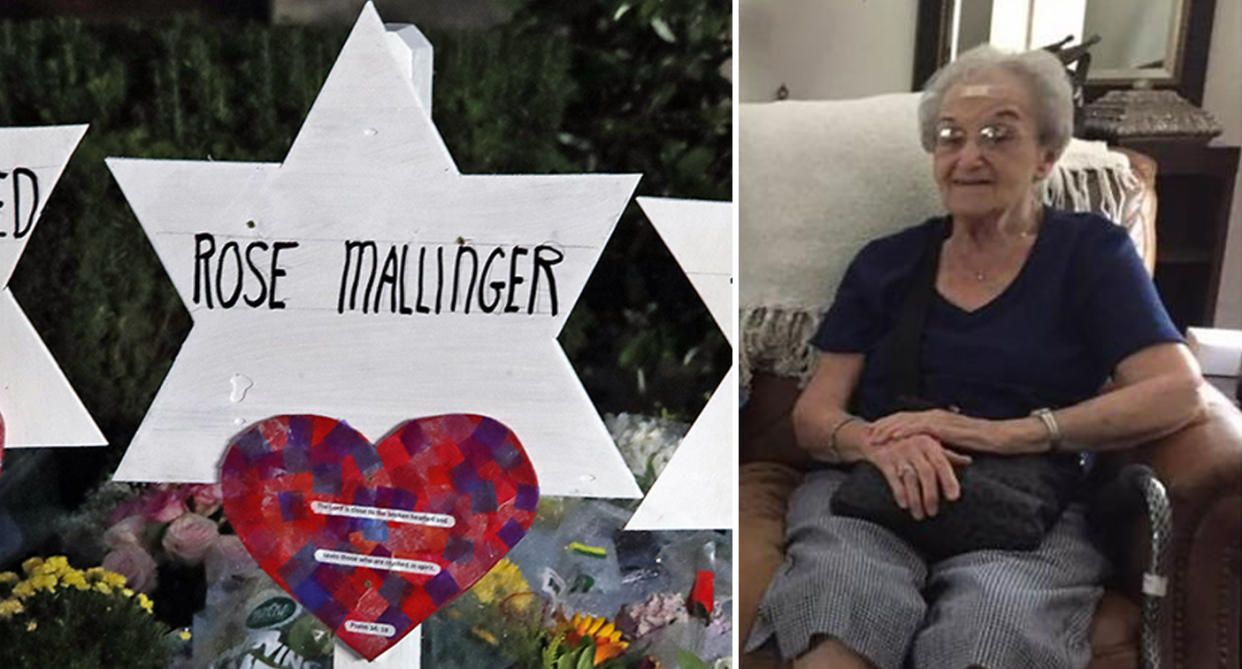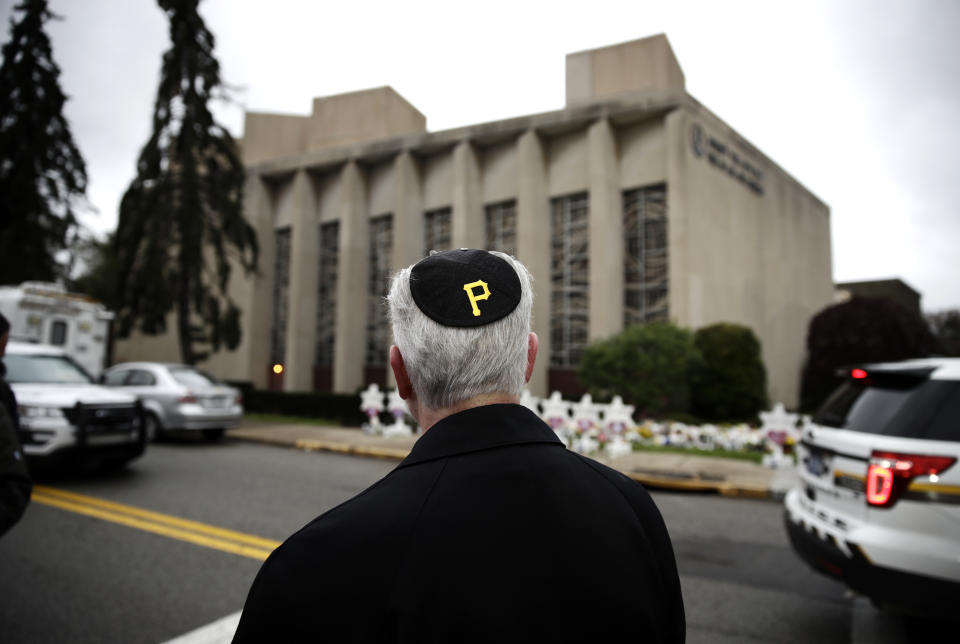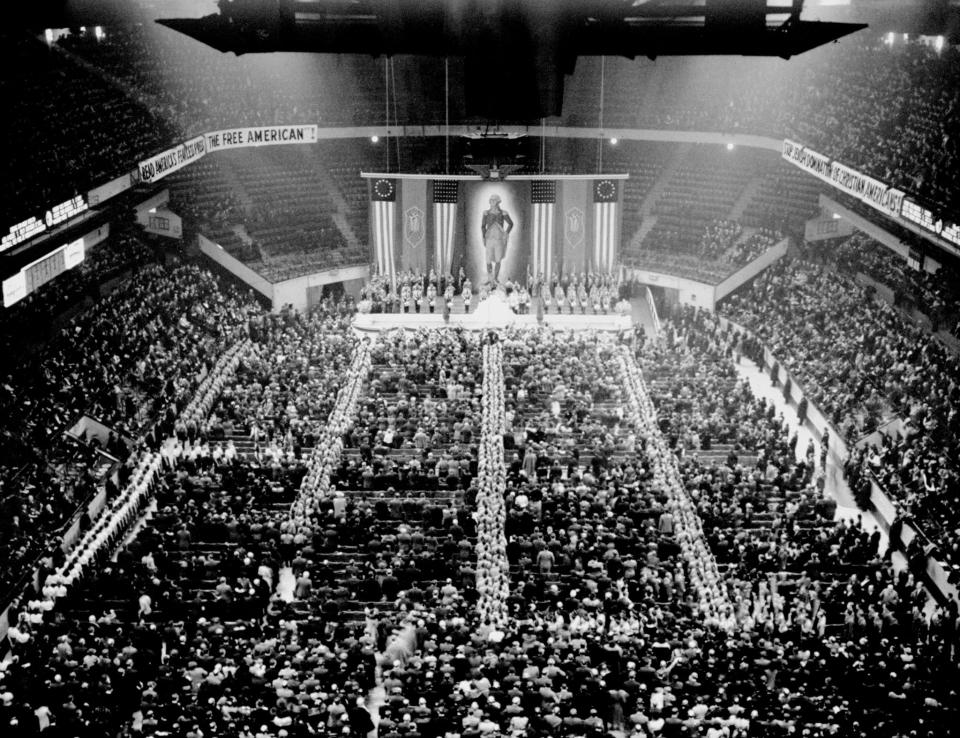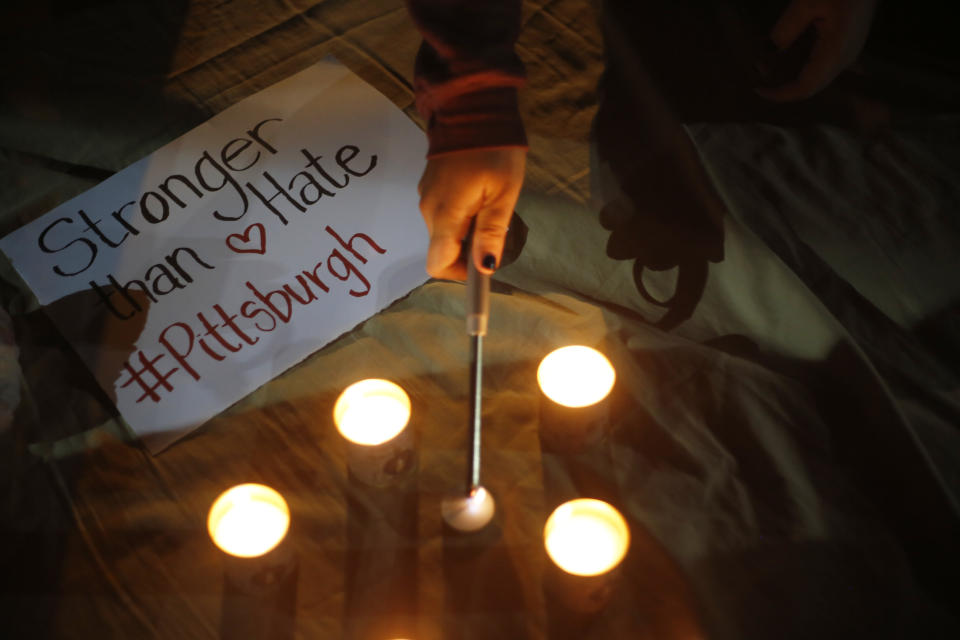Over nearly a century, Rose Mallinger saw the best and worst of America. Until Saturday.

In the ghastly scrapbook of tragedy, this will be the one where the victims were older. At Sandy Hook, they were first-graders. At Marjory Stoneman Douglas High School, they were teens. At Tree of Life synagogue in Pittsburgh on Saturday morning, they were grandparents, their average age 74.
The gunman aimed at pews filled with grayed heads and timeworn faces — faces that had lived through so much of the past — and fired, killing 11 congregants.
None had seen more than 97-year-old Rose Mallinger, whose 61-year-old daughter (injured but expected to recover) brought her to worship every Shabbat. Described as a “petite” and “vivacious”, “spry” and “vibrant”, “she had a lot of years left,” said a woman who had been a student when Mallinger worked in the school office long ago.
And a lot of years lived — years filled with warnings of preamble and prologue to this massacre. For while the slaughter of 11 worshippers by a white supremacist carrying an assault rifle and three handguns was the deadliest attack on American Jews, it was not the first.
When Mallinger was born nearly a century ago, the welcome door to the United States was closing. Until the start of the 20th century, the millions who arrived at ports were called newcomers not foreigners, and — with the conspicuous exception of Chinese people, who were banned completely after 1882 — all it took to enter the country was the price of steerage passage and the name of someone — anyone — who was already here. More than 20 million immigrants did just that between 1881 and 1914, including 1.5 million Jews from Eastern Europe. The Tree of Life synagogue was given roots by these immigrants. Founded in 1865, it took its current name in 1883.

Slideshow: Mourning the victims of the Pittsburgh synagogue attack >>>
When Rose Mallinger was born in 1921 — census records appear to show she was the fourth of six children of Yiddish-speaking parents who had themselves arrived in the U.S. from Lithuania as children — nativism and isolationism were already taking hold. Most notably, there were the Palmer raids in 1920, when the U.S. Department of Justice arrested as many as 10,000 people in 30 cities and deported many of them as radicals and anarchists. The targets were of Italian and Eastern European descent — Catholics and Jews who were “other” in a nation that was mostly Protestant.
The admission of Jews had been reduced to a trickle by the time Rose was born — just 20,000 immigrated between 1918 and 1921. Three years later, Congress passed the Immigration Act of 1924, which established the first quotas. Its stated purpose was to preserve American “homogeneity.”
During the 1930s, the anti-Semitic fever that was sweeping Germany affected America as well. A 1939 Roper poll found 60 percent of Americans considered Jews to be “greedy” “dishonest” and “pushy”, and 53 percent believed “Jews are different and should be restricted.” The “radio priest”, Father Charles Coughlin, told his millions of listeners that the Great Depression was caused by Jewish bankers. The aviator Charles Lindbergh, the most famous American civilian of his generation, accused Jews of “pressing this country toward war” against fascism. Lindbergh was a prominent spokesman for the non-interventionist America First Committee, an organization (which disbanded within days of the attack on Pearl Harbor) whose name has been invoked by latter-day self-proclaimed “nationalists,” including President Trump.
Later in the decade, Nazi supporters held parades in Manhattan and the German American Bund gathered 20,000 at a rally at Madison Square Garden, where its leader denounced President Franklin Roosevelt’s New Deal as the “Jew Deal.” European Jews fleeing Hitler, if they weren’t Albert Einstein, were turned away by the U.S. One government report later found that up to 200,000 people could have been saved had Roosevelt expanded immigration quotas still in effect from 1924.

And so it went through the decades, as incidents of anti-Semitism were met with condemnation — which, American Jews told themselves, made this country better than the ones their families had fled, where attacks on Jews went unanswered.
Had Rose Mallinger’s family remained in Europe, her fate during the Holocaust would likely have been unspeakable.
History will show that it was wrong to be isolationist, American Jews came to believe, wrong to turn away refugees fleeing their homeland, wrong to see people merely as their accent or their ancestry, their skin color, their religion. They believed that during the 1950s, when Rose Mallinger married and had her own family, when the first Holocaust denial books began to appear, when Congress reaffirmed quotas with the Immigration and Nationality Act of 1952, when a disproportionate number of Jews were called in by the House UnAmerican Activities Committee. And during the 1970s, when Rose’s children attended Tree of Life, now in its new home in the Squirrel Hill neighborhood of Pittsburgh, and Nazi sympathizers attempted to march through Skokie, Ill.

They believed it during the emergence of what some academics are calling “New anti-Semitism” — accusations that American leaders support Israel because of pressure from a “Jewish lobby”, an increase in the appearance of swastikas spray-painted on college campuses, and through nearly 10,000 anti-Semitic “incidents” tallied by the Anti-Defamation League.
And, in fact, some of their belief was justified. American Jews were indeed safer than Jews in other countries. Restrictions against Jews are long gone from American universities, country clubs and neighborhoods. And polls did show a decrease in the hatred — an ADL monitoring survey found 19 percent of the U.S. population held anti-Semitic attitudes, compared with 24 percent in Western Europe and 74 percent in the Middle East and North Africa.
Then came the election of 2016. Slowly the realization dawned that the assumption of lessons learned was dependent on leadership from the top — that while anti-Semitism is not new, never before has the talk come from the White House. Earlier presidents were far from perfect. Woodrow Wilson’s biographers agree he was a racist and an anti-Semite; Franklin Roosevelt (aware of the possibility of a political backlash) personally ordered ships of Jewish refugees to be turned away. But no other president has publicly called neo-Nazi marchers “some very fine people” or retweeted cartoons from white supremacists, or called himself a “nationalist”, distinguished from “globalists” like George Soros — either unaware or unconcerned about the history of the phrase.

In the ten days after Trump was elected, there were more than 900 hate crimes against Muslims, people of color and Jews, and the Anti-Defamation League reported a 57 percent rise in anti-Semitic incidents — everything from bomb threats to vandalism — in the U.S. in 2017, compared to the year before. In February 2017, after Trump’s inauguration, more than 100 gravestones were vandalized at Jewish cemeteries outside Philadelphia and St. Louis, Mo. In Charlottesville, Va., six months later, skinheads and neo-Nazis held torches and chanted, “Jews will not replace us.”
“We all need to learn the lessons of history and stand up in our own time and our own lives,” said a statement of solidarity with Pittsburgh from the Chicago History Museum. In her 97 years, Rose Mallinger’s life was that history. She lived through times when her country did well by all the flavors in its melting pot, and through times when it did not.
She survived them all, until she didn’t.
“It looks definitely like it’s an anti-Semitic crime,” Trump said hours after the shooting, which killed 11 and wounded six. “That is something you wouldn’t believe could still be going on.”
Would Rose Mallinger have believed?

“May her memory be for a blessing,” Jews say in a house of mourning — a prayer that the family will be comforted by their memories and that future generations will be inspired.
“May her memories be for a blessing,” we might also say today. The lessons of the past — her past, the nation’s — might light us to a better way, if attention is paid.
_____
Read more from Yahoo News:

